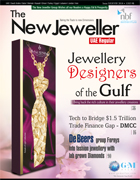
 |
|
| Home Technology / Education Events & News Archives Designs e - NewsLetter |
|
GIA Research Scientists to Offer Advanced Synthetic Diamond Seminar
Focus on Identification of Natural & Synthetic Diamonds;
First Session in Hong Kong June 19
“GIA examined and characterized the earliest gem-quality synthetic diamonds nearly 50 years ago. Since then, we have continued to build the Institute’s expertise in identifying synthetics through robust, published research into their properties. This combination of decades of experience in delivering quality, relevant education and in-depth independent research into natural and synthetic diamonds is unique to GIA,” said Dr. Wuyi Wang, vice president of research and development. “As the public becomes more aware of gemquality synthetic diamonds – including melee sizes – it is imperative that the industry is prepared with training and expertise to address consumer concerns.” The first seminar will be offered at the GIA school in Hong Kong on June 19, just before the start of the Hong Kong Gem Show. GIA senior research scientist Dr. Ulrika D’Haenens-Johansson will present the seminar along with bilingual GIA education staff. The cost of the Hong Kong seminar is HK$6,000 and registration is limited to 15 participants. Those interested in registering for the full-day seminar should contact GIA in Hong Kong (telephone +852 3166 7001; email giahongkong@gia.edu). The seminar will be offered at other GIA locations later in the year. The date, length, specific topics and cost of the seminar will vary by location. More information will be available at a later date. Seminar participants will gain in-depth knowledge of advanced diamond identification techniques and will have hands-on experience with current production synthetic diamonds and the latest detection technology. The combination of lecture and lab will leverage the expertise of GIA research scientists and the education skills and experience of GIA instructors. The GIA research scientist presenting the seminar will have expert knowledge of synthetic diamond as a material, its identification and gemological characteristics, along with the processes used by GIA’s laboratories to separate synthetic from natural diamonds. The seminars will cover the most important topics related to diamond identification. • Natural and synthetic diamond formation, diamond defects and their analysis, (including the basic principles of spectroscopy) • The gemological properties of chemical vapor deposition (CVD) and high-pressure, high-temperature (HPHT) grown synthetic diamonds • Post-growth treatment of synthetic diamond • The analytical instrumentation used by laboratories to identify synthetic diamonds • Hands-on sample examination of natural and synthetic diamonds • Hands-on operation of GIA instruments including the GIA iD100™, GIA DiamondCheck™, and longwave and shortwave UV viewing box. Dr. Ulrika F.S. D’Haenens-Johansson is a senior research scientist at the GIA laboratory in New York. Her area of research and expertise is the defect physics of natural, treated and synthetic diamond materials using optical and EPR spectroscopy. She earned a master’s in physics with honors at the University of Warwick, United Kingdom in 2007 and a doctorate in physics, also at the University of Warwick, in 2011. Her thesis was Optical and Magnetic Resonance Studies of Point Defects in CVD Diamond. For more information about synthetic diamonds, search GIA.edu for ‘synthetic diamonds.’ |